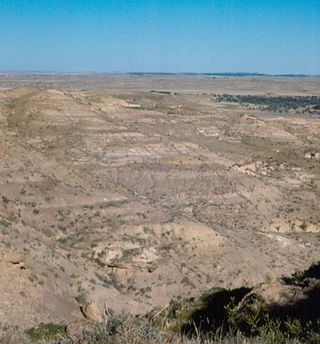
The Lance (Creek) Formation is a division of Late Cretaceous rocks in the western United States. Named after Lance Creek, Wyoming, the microvertebrate fossils and dinosaurs represent important components of the latest Mesozoic vertebrate faunas. The Lance Formation is Late Maastrichtian in age, and shares much fauna with the Hell Creek Formation of Montana and North Dakota, the Frenchman Formation of southwest Saskatchewan, and the lower part of the Scollard Formation of Alberta.
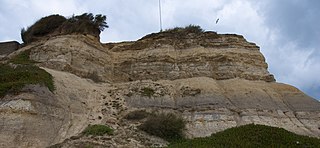
The Wealden Group, occasionally also referred to as the Wealden Supergroup, is a group in the lithostratigraphy of southern England. The Wealden group consists of paralic to continental (freshwater) facies sedimentary rocks of Berriasian to Aptian age and thus forms part of the English Lower Cretaceous. It is composed of alternating sands and clays. The sandy units were deposited in a flood plain of braided rivers, the clays mostly in a lagoonal coastal plain.

The Laramie Formation is a geologic formation of the Late Cretaceous (Maastrichtian) age, named by Clarence King in 1876 for exposures in northeastern Colorado, in the United States. It was deposited on a coastal plain and in coastal swamps that flanked the Western Interior Seaway. It contains coal, clay and uranium deposits, as well as plant and animal fossils, including dinosaur remains.

The Cloverly Formation is a geological formation of Early and Late Cretaceous age that is present in parts of Montana, Wyoming, Colorado and Utah in the western United States. It was named for a post office on the eastern side of the Bighorn Basin in Wyoming by N.H. Darton in 1904. The sedimentary rocks of formation were deposited in floodplain environments and contain vertebrate fossils, including a diverse assemblage of dinosaur remains. In 1973, the Cloverly Formation Site was designated as a National Natural Landmark by the National Park Service.

The Arundel Formation, also known as the Arundel Clay, is a clay-rich sedimentary rock formation, within the Potomac Group, found in Maryland of the United States of America. It is of Aptian age. This rock unit had been economically important as a source of iron ore, but is now more notable for its dinosaur fossils. It consists of clay lenses within depressions in the upper part of the Patuxent Formation that may represent oxbow swamp facies. It is named for Anne Arundel County, Maryland.
The Argiles Ostréennes is a geological formation in northern central France whose strata date back to the Early Cretaceous. Dinosaur remains are among the fossils that have been recovered from the formation.
The Dinosaur Beds is a geological formation in Malawi whose strata date back to the Early Cretaceous. The age of the deposit is poorly constrained, but is likely to date from the Barremian to Aptian. Dinosaurs, turtles and crocodylomorphs remains are among the fossils that have been recovered from the formation. It is correlated with the Galula Formation in Tanzania. It consists of two members, a lower unfossiliferous member consisting of deep red stained sandstones, and an upper fossiliferous member consisting of white sands and grey to red mudstones and siltstones. The upper member is 210 m thick in the vicinity of the CD-9 locality.

The Eagle Sandstone, originally the Eagle Formation, is a geological formation in Montana whose strata date back to the Late Cretaceous. It is a light to brownish gray to pale yellow-orange, fine-grained sandstone. It contains areas of crossbedding and local shale members. It contains large sandy calcareous concretions. Its thickness varies from 100 to 350 feet due to the lens nature of the individual sandstone layers and local interbedded sandy shale layers.
The Xiaoyan Formation is a geological formation in Anhui, China whose strata date back to the Late Cretaceous. Dinosaur remains are among the fossils that have been recovered from the formation. It overlies the older Qiyunshan Formation which it forms the Huangshan Basin with, and was deposited between the Campanian and Maastrichtian stages.
The Douiret Formation is a geologic formation in Tunisia, near the Berber village of Douiret. It is part of the larger Continental Intercalaire Formation, which stretches from Algeria and Niger in the west to Egypt and Sudan in the east. The Douiret Formation is located in the Tataouine basin in southern Tunisia, stretching into Algeria and Libya, and is part of the Merbah el Asfer Group of rock formations. The Douiret is 80 metres thick and consists of a 30-metre layer of sand beneath a 50-metre layer of clay.

The Meeteetse Formation is a Late Cretaceous geologic formation occurring in Wyoming.

The Point Lookout Sandstone is a Cretaceous bedrock formation occurring in New Mexico and Colorado.
The Marshalltown Formation is a Mesozoic geologic formation. Dinosaur remains diagnostic to the genus level are among the fossils that have been recovered from the formation.
The Mount Laurel Formation is a Mesozoic geologic formation located in New Jersey and Delaware. Dinosaur remains diagnostic to the genus level are among the fossils that have been recovered from the formation. Dinosaur teeth recovered from this formation include tyrannosauroid teeth similar to those of Dryptosaurus, as well as teeth from a ~3-4m saurornitholestine dromaeosaurid. Other fossils include: Belemnites in the genus Belemnitella, Oysters such as Exogyra and Pycnodonte, and rare mosasaur, turtle, and plesiosaur remains.
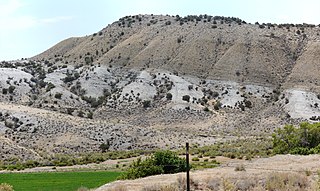
The Mowry Shale is an Early Cretaceous geologic formation. The formation was named for Mowrie Creek, northwest of Buffalo in Johnson County, Wyoming.
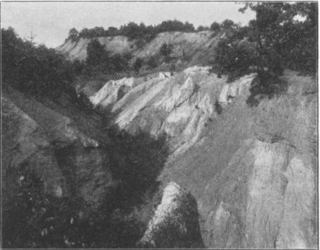
The Patuxent Formation is a Cretaceous geologic formation of the Atlantic coastal plain.
The Hornerstown Formation is a Paleogene or latest Mesozoic geologic formation in New Jersey. The age of these deposits have been controversial. While most fossils are of animals types known from the earliest Cenozoic era, several fossils of otherwise exclusively Cretaceous age have been found. These include remains of the shark Squalicorax, several types of non-avian dinosaurs, the teleost fish Enchodus, several species of ammonite, and marine lizards referred to the genus Mosasaurus. Some of these remains show signs of severe abrasion and erosion, however, implying that they are probably re-worked from older deposits. Most of these fossils are restricted to the lowest point in the formation, one rich in fossils and known as the Main Fossiliferous Layer, or MFL. Other explanations for the out-of-place fossils in the MFL is that they represent a time-averaged assemblage that built up and remained unburied during a time of low sediment deposition, or that they were stirred up from deeper in the sediment and deposited together during a tsunami.
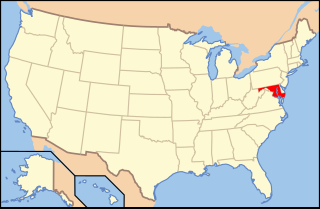
Paleontology in Maryland refers to paleontological research occurring within or conducted by people from the U.S. state of Maryland. The invertebrate fossils of Maryland are similar to those of neighboring Delaware. For most of the early Paleozoic era, Maryland was covered by a shallow sea, although it was above sea level for portions of the Ordovician and Devonian. The ancient marine life of Maryland included brachiopods and bryozoans while horsetails and scale trees grew on land. By the end of the era, the sea had left the state completely. In the early Mesozoic, Pangaea was splitting up. The same geologic forces that divided the supercontinent formed massive lakes. Dinosaur footprints were preserved along their shores. During the Cretaceous, the state was home to dinosaurs. During the early part of the Cenozoic era, the state was alternatingly submerged by sea water or exposed. During the Ice Age, mastodons lived in the state.
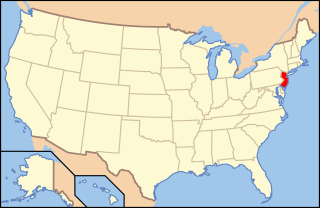
Paleontology in New Jersey refers to paleontological research in the U.S. state of New Jersey. The state is especially rich in marine deposits.
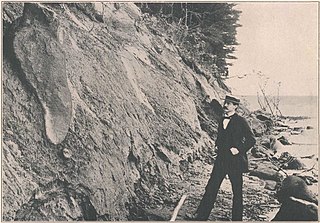
The Matawan Formation is a geologic formation in Maryland and New Jersey. It preserves fossils dating back to the Cretaceous period.















